2017
NDSU Extension Service 2017 Crop Survey Commences
The 2017 integrated pest management (IPM) small grain, soybean and sunflower field survey officially began on Wednesday, May 24 with scout training conducted at the Carrington Research Extension Center. The program is managed by the NDSU Extension Service, in cooperation with the ND Dept. of Ag., to identify North Dakota crop pest presence in random commercial fields. Use of the survey data includes farmer, crop adviser and ag industry education; support for exporting ND crops; and reference for educational and research projects.
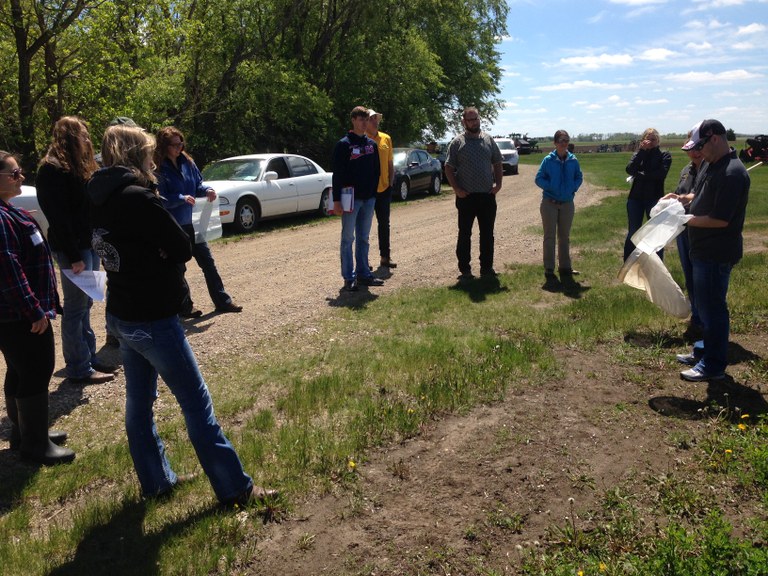 2017 IPM scout training.
2017 IPM scout training.
State IPM survey coordinators are Jan Knodel, extension entomologist; Patrick Beauzay, State IPM coordinator and entomology research specialist; and Sam Markell and Andrew Friskop, extension plant pathologists. Brittney Aasand, crop scout based at the Carrington REC and supervised by Greg Endres, will survey fields in 11 south-central counties: Burleigh, Dickey, Eddy, Emmons, Foster, Kidder, LaMoure, Logan, McIntosh, Stutsman, and Wells.
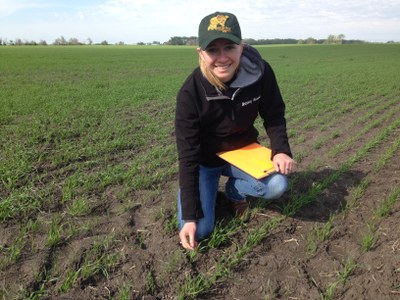
Brittney Aasand, 2017 south-central IPM scout.
The small grain (primarily spring wheat but also barley and winter wheat) survey will be conducted during late May to early August, primarily for leaf and head diseases, and insects. Primary diseases to be monitored in the survey are bacterial leaf blight, barley yellow dwarf virus, rust (leaf, stem and stripe), Fusarium head blight (scab), Septoria, loose smut, net and spot blotch (barley), tan spot (wheat), and wheat streak mosaic virus (wheat). Insects to be surveyed are grasshoppers, aphids, barley thrips, wheat stem maggot and sawfly.
Sunflower fields will be inspected during mid June through mid August for grasshoppers, downy mildew, rust and verticillium wilt. Soybean fields will be surveyed to monitor grasshoppers, soybean aphid, bean leaf beetle and spider mites.
Greg Endres
gregory.endres@ndsu.edu
Agronomy Extension Specialist
Hungry Caterpillars, Borers and Fungi
We went from deep snow to warm temperatures quite quickly this spring which made pruning dormant wood a challenge. I know from experience that I need to prune in this order: Currants (because their buds break so early), Haskaps (because they bloom so early), Juneberries (early bloom), Cherries/Apples, grapes (okay to prune as buds as well so you can see what’s alive) and then plums after bloom. But honestly, the project has become so big after all these years, that I just do the best I can.
I’ve received questions about ‘webs in trees.’ These are tent caterpillars. The eggs are those hard, foamy black masses that you find on branches as you prune. Then the caterpillars hatch out and become eating machines. Trees can handle some defoliation – they’ll just grow the next set of leaves out after the caterpillars pupate into moths. But it looks bad and adds a little stress to the tree. Just take a stick, or your gloved hand, and pull down the web nest in the evening. Pesticides are not necessary! But you if you have to, try a pyrethrin or Bt product.
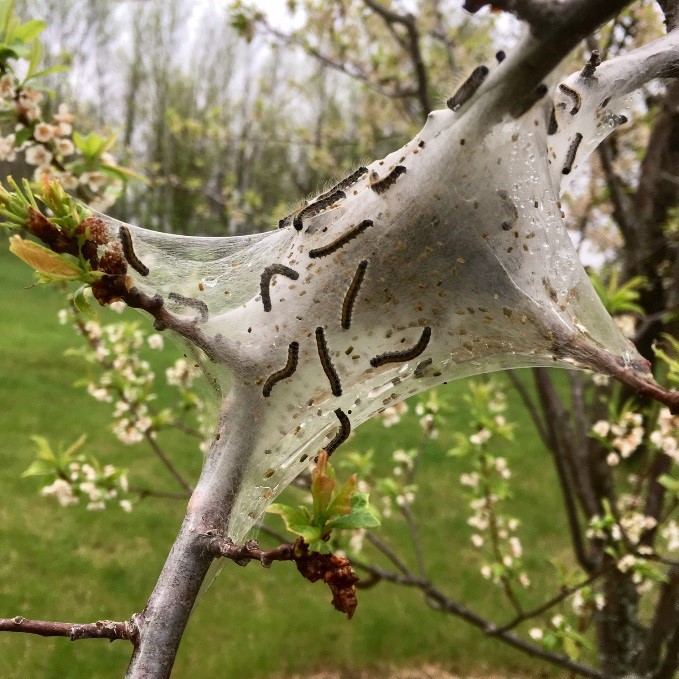
Tent caterpillars.
I was told they would come and they have: Currant borers. We’ve had them several years now and their numbers built up because, for a while, I thought the funny growth was the remnant of winter injury. The insect likes all colors and types of currant and gooseberry. If you have slow, puny leaf growth with what looks like ‘all flowers, or all fruit’ on the canes, cut it out now at the base and burn it or discard it in your trash. I decided to do a big cleanup in the older plants this year.
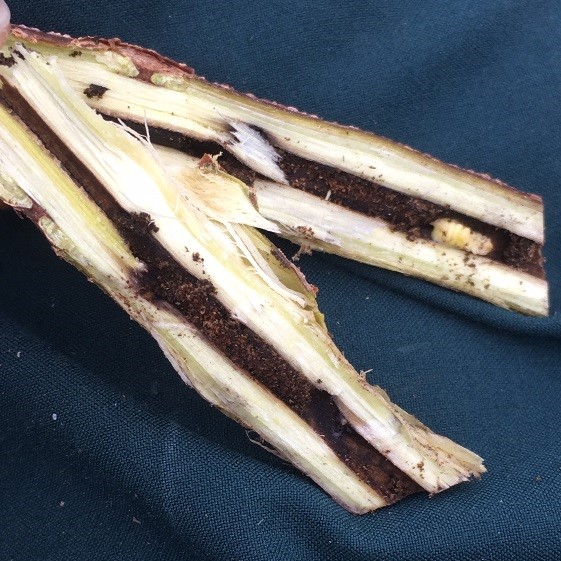
Currant Borer in the cane in April.
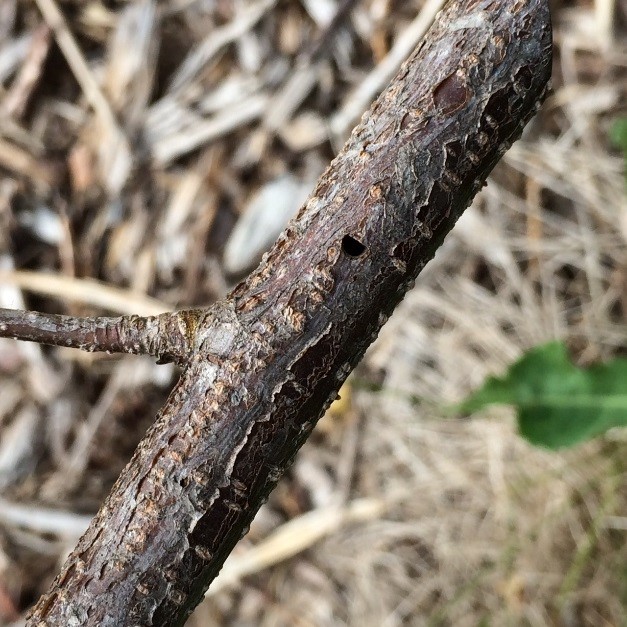
Currant borer exit hole in mid-June.
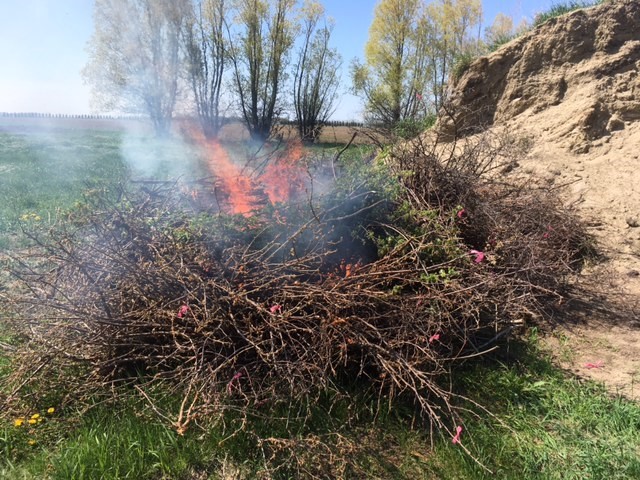
Years of effort and ignorance. Removed all canes older than one year.
And just for fun (there are a lot of other beautiful, fun things here too like birds and bees and flowers!): Fairy rings! We have lots of them, probably due to all the old shrubs removed 10 years ago. Below is a picture of 2 small ones growing near each other. If you look at the CREC in satellite map view, you can see several big ones on the west end of the orchard! They never cause grass death here and I never see mushrooms. They just make me happy.
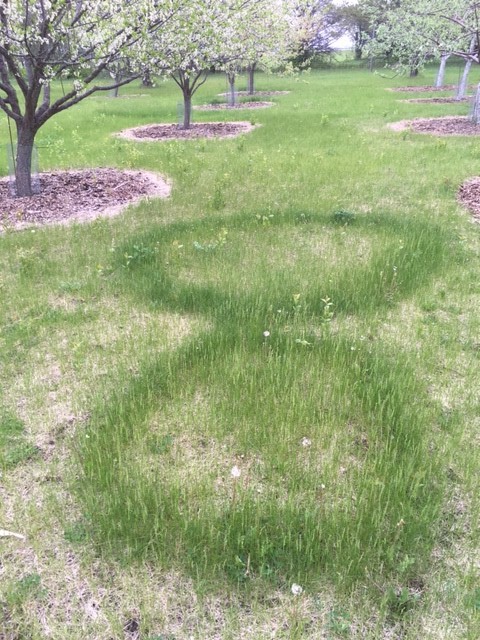
Fairy rings.
Enjoy this stretch of cool weather which makes our spring flowers last longer.
Kathy Wiederholt
kathy.wiederholt@ndsu.edu
Fruit Project Manager
Spring is in the Air
The spring season is always my favorite time of year. In agriculture, our typical planting season starts in the middle of April. With winter in the rear view mirror, the increased minutes of sunlight every day are a welcoming gesture to the start of another bountiful growing season.
Last year the planting of foundation seedstocks started on April 5. Lower amounts of fall rain and snow accumulation of 36 inches yielded drier field conditions allowing most fields to be free of wet potholes. This led to early spring plantings with good growing conditions in most areas that resulted in production of very high yields.
In 2016, the CREC foundation seedstock program raised 13 crops and 32 cultivars. Table 1 shows the crops and number of cultivars for each. This production was spread across 1430 acres.
Table 1. 2016 CREC Seedstock Crops and Cultivars
The spring of 2017 is starting different from the spring of 2016. Moderate fall rain and 57 inches of snow provided much needed moisture. Seedstocks planting started on April 14 with barley. We will raise 37 cultivars among our 12 crops (Table 2). This production will be on 1500 acres. These two years show the diversification of the CREC foundation program.
Table 2. 2017 CREC Seedstock Crops and Cultivars
Regardless of the hectic pace to plant this diverse seedstock, employee safety is always highest priority at the CREC. Seed purity is number two. Foundation grade seed is easily lost if purity is not maintained. In the world of certified seed, a specific variety represents a unique set of plant characteristics. Foundation grade seed represents a seedlot where those characteristics may be expressed at the highest level.
Managing foundation seed requires careful steps to ensure purity and all of these varieties equates to even more extra effort and care. Every piece of equipment needs to be free of seed contaminants before a variety is planted. The list of equipment used is extensive: bins, conveyors, small metal tubs, seed treatment canister, forklifts, totes, a seed tender and drills.
No matter how busy the spring season becomes you cannot rush, take short-cuts, or partially clean the equipment used for each different variety. Our drill typically takes two to three hours to fully clean. Any other transfer equipment being used also needs cleaning. A portable air compressor and generator are valuable tools in this process. The planted acreage of our varieties can range from three to 100 acres. Depending on the acreage we are seeding, we often spend more time cleaning all the equipment than the time required to actually complete the planting. When weather conditions limit the days for planting this can be a real frustration! With all that said, we will continue to take the time to follow these practices of producing foundation grade seed so that the seedsman receives the purity they should expect.
Dave Copenhaver
David.Copenhaver@ndsu.edu
Foundation Seedstocks Research Spec.
2016 Farm Business Management Year in Review
As spring planting is hitting full speed, the 2016 Averages for the Farm Business Management Programs across North Dakota are being wrapped up.
For the average farm, 2016 looked to be a very good year. Above average to excellent yields helped to put the average net farm income for farms enrolled in the Carrington Farm Business Management Program at $301,669. This is up significantly from 2015 when the average net farm income for those enrolled in the program was $2,464.
Soybeans led the way for crop profitability on cash rented land, averaging a net return of $120.37 per acre. They were closely followed by barley with an average net return of $119.84. Profitability was lower on corn and wheat, but still positive, at $17.21 and $16.84 respectively. Average yields for most crops came in well above historical averages for the Carrington Farm Management Program.
Lower market prices for feeder cattle played a large part in a lower average profit per cow for farms enrolled in the program. The net return per cow averaged $117.54 in 2016 compared with $388.27 in 2015.
Producers looking more information on the Farm Management Program or wanting to look at their own numbers can certainly call with any questions. Additional data and information for different areas of North Dakota will be available at www.ndfarmmanagement.com.
Jory Hansen
J.Hansen@ndsu.edu
Farm Business Management Instructor
Winter Rye Variety Evaluations at the CREC
The 2017 spring is off to a slow start at the CREC with very little spring seeding going on and essentially no emergence of spring planted grains. Fall sown cereal crops are a different story though with winter wheat, winter triticale, and winter rye growing despite the cool soil and weather conditions. It is quite evident that winter rye is growing more compared to the other cereals as it has the ability to grow under these cool conditions with significant growth as observed in the photograph below. It is also apparent that differences in winter hardiness, vigor and early season growth exist amongst the varieties planted at the CREC this spring. These traits are important as winter rye is increasingly being used for cover crop applications in North Dakota.
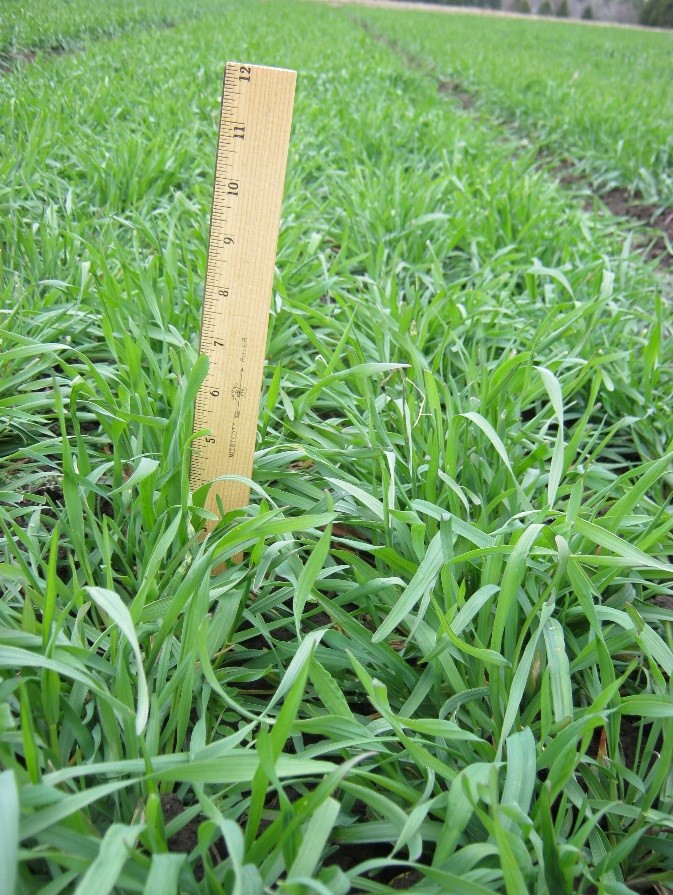
Early growth of winter rye in the organic variety trial.
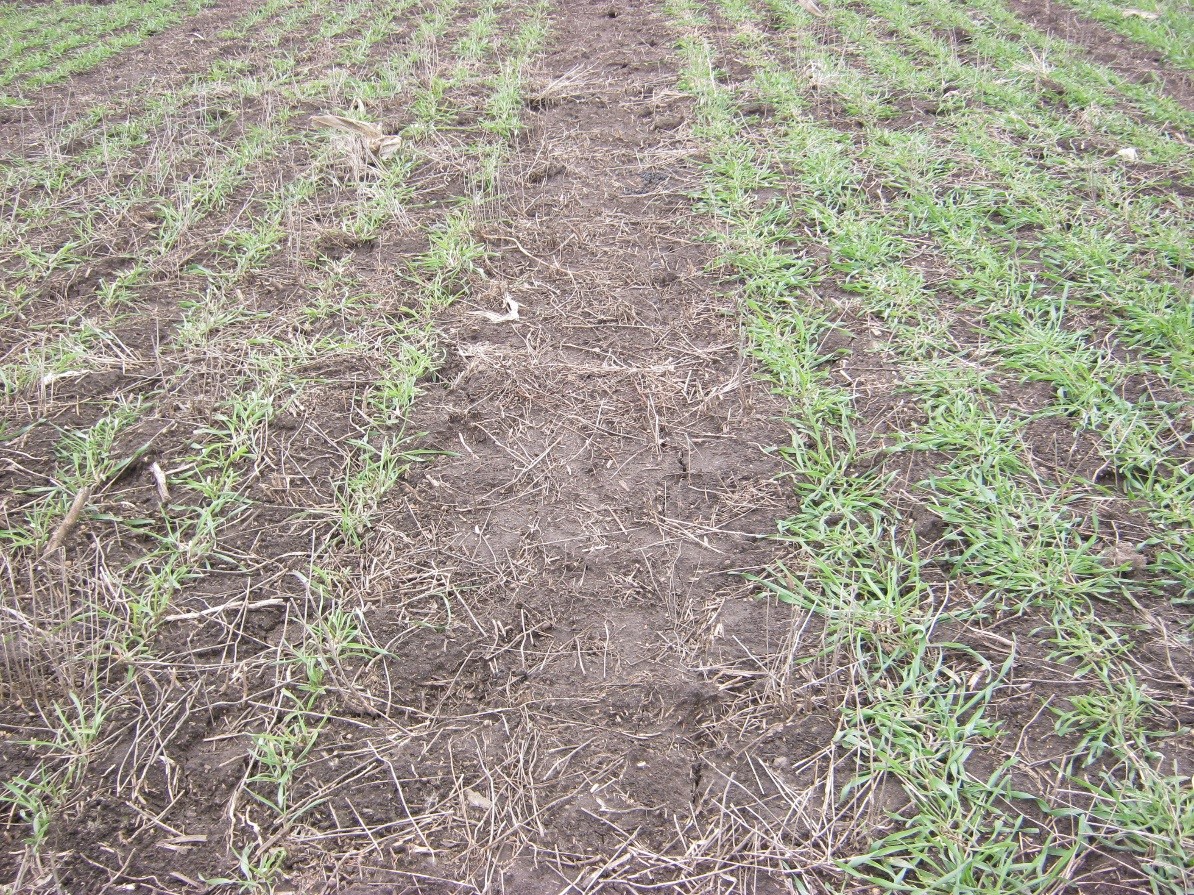
Winter survival and early vigor differences in the conventional winter rye variety trial direct seeded into flax stubble.
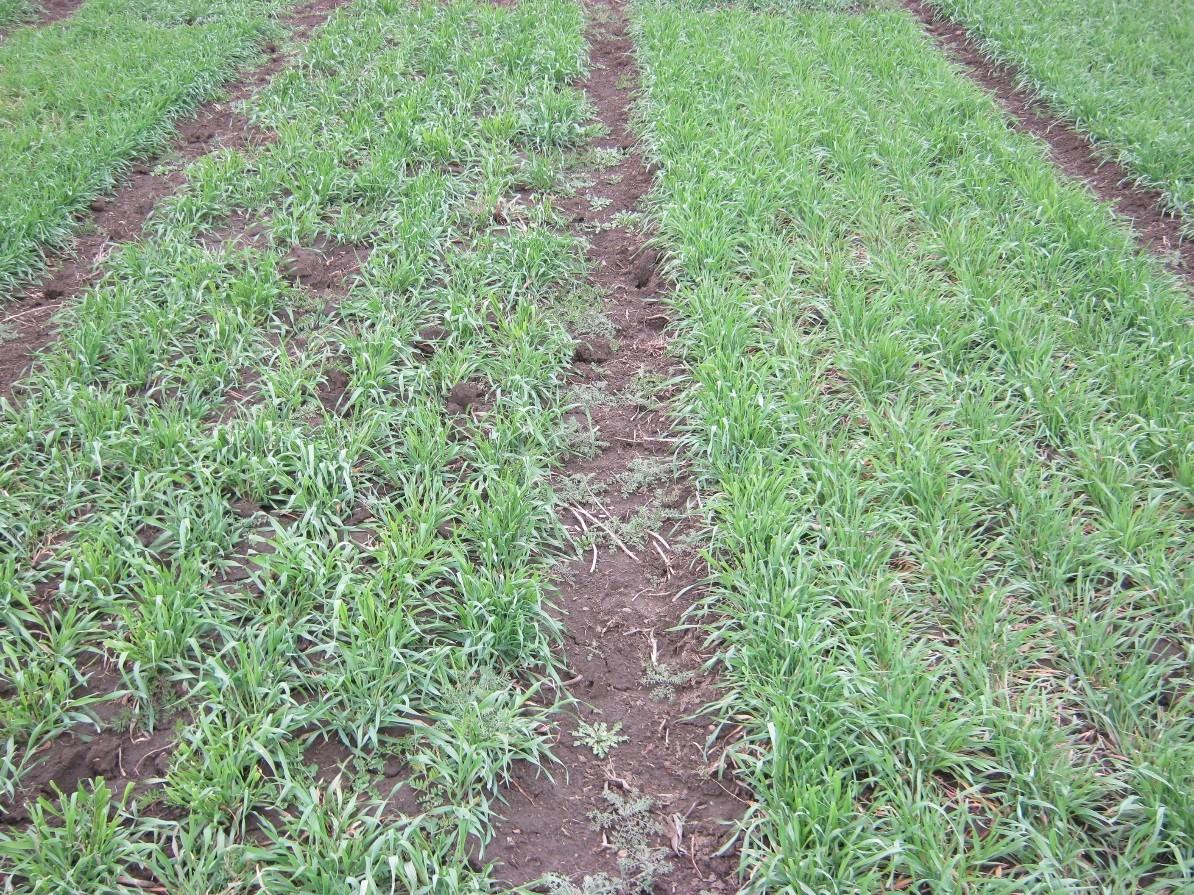 Winter survival and early vigor differences in the organic winter rye variety trial sown into cultivated (bare) dry bean ground that had hail damage last year.
Winter survival and early vigor differences in the organic winter rye variety trial sown into cultivated (bare) dry bean ground that had hail damage last year.
Trials were planted in the fall of 2016 by CREC staff to evaluate varieties for grain yield (both conventional and organic), forage production, tolerance to saline conditions, and an off station site near Wishek for grain production. The CREC also coordinates the state variety testing program and sent the varieties to Research Centers at Minot, Hettinger, Langdon, and Williston.
Variety trial data is available from individual Research Extension Center Annual reports, Extension Bulletin A1049-16 or the NDSU variety trial website below. A list of varieties currently planted at all sites is also listed below.
https://www.ag.ndsu.edu/varietytrials/winter-rye
|
Hancock |
1979 release from University of Wisconsin |
|
Spooner |
1993 release from University of Wisconsin |
|
Rymin |
1973 release from University of Minnesota |
|
ND Dylan |
New NDSU release in 2016 |
|
Dacold |
NDSU release in 1989, only common seed available |
|
Aroostok |
Early variety used for cover crop released by USDA in 1981 |
|
AC Hazlet |
High yielding variety from Canada released in 2006 |
|
Wheeler |
Late variety from Michigan State University released in 1971 |
|
Brasetto |
New hybrid winter rye from KWS Germany |
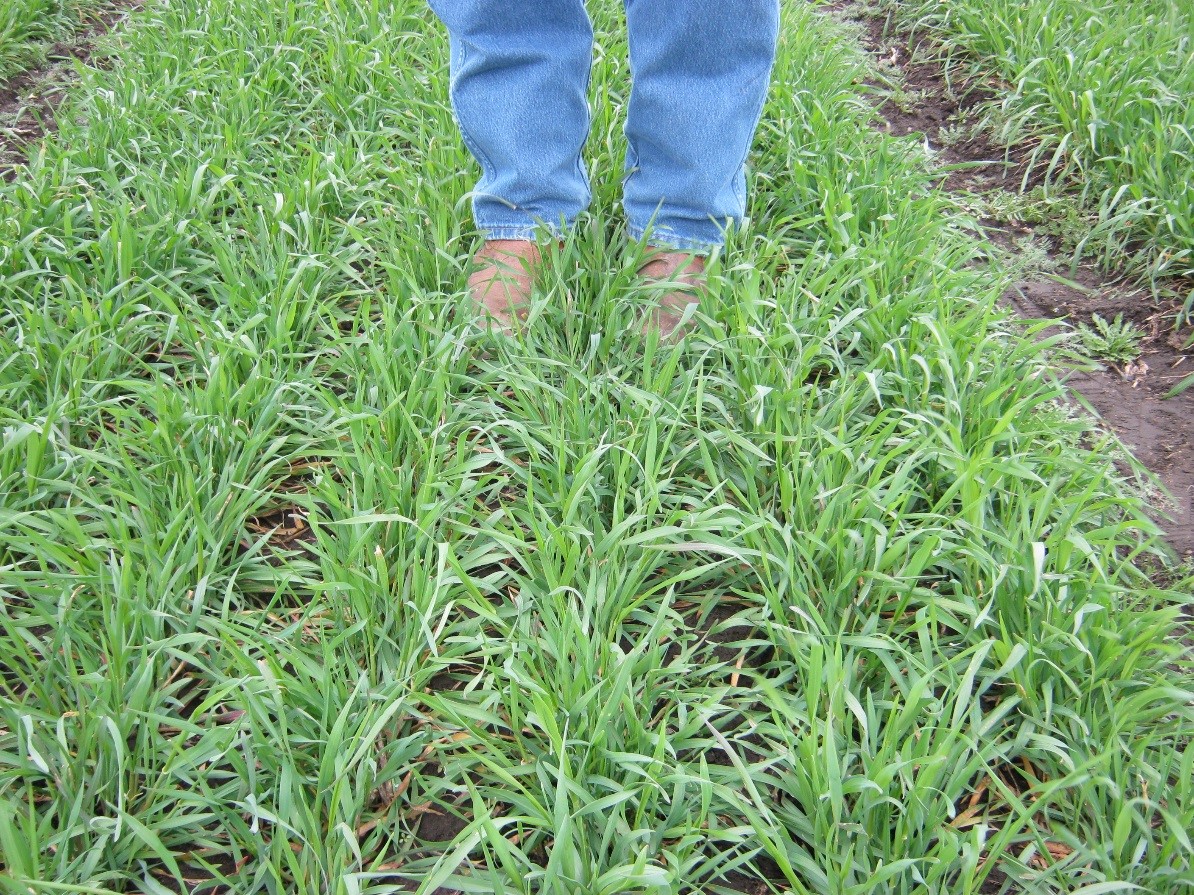 An early NDSU winter hardy experimental being developed at the CREC for cover crop use.
An early NDSU winter hardy experimental being developed at the CREC for cover crop use.
Steve Zwinger
Steve.Zwinger@ndsu.edu
Agronomy Research Specialist
Synchronizing Protocols for Breeding Cows and Heifers
There are many advantages to synchronizing breeding in the cow herd:
- Breeding to high accuracy bulls via artificial insemination
- Grouping cows to calve within a shorter calving period
- Reducing estrus detection labor by breeding cattle on timed artificial insemination protocols
- Better feeding management when stage of gestation is known via breeding date
Improved conception results occur when cattle are on an increasing plane of nutrition, reduced stress or movement, no diet changes, and following synchronization protocols closely.
Sometimes producers express dismay when conception rates to timed AI (artificial insemination) are only 50%. Realistically, 60-70% is rather good and exceptional is when 80% conception rates to timed AI are achieved. Synchronization protocols have best success when strictly followed. You can read more about maximizing pregnancy rates when using AI here.
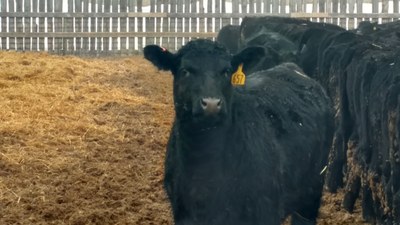
Beef Heifer
The Beef Reproduction Task Force has researched and compiled various synchronization protocols. These protocols are slightly different between cows and heifers and can be viewed at http://beefrepro.unl.edu/resources.html
For cows, the short-term Fixed-Time AI protocols are either ‘7-day CO-Synch + CIDR’ or ‘5-day CO-Synch + CIDR’.
The short-term ‘7-day CO-Synch + CIDR’ protocol starts with insertion of a CIDR and an injection of GnRH (gonadotrophin releasing hormone) on day 0. On Day 7, the CIDR is removed and an injection of Prostaglandin F2 alpha is given. At 60 to 66 hours later, all cows are injected with GnRH and artificial inseminated. Protocol length: 10 days
For heifers, the short-term Fixed-Time AI protocols are either ‘7-day CO-Synch + CIDR’ or ‘5-day CO-Synch + CIDR’:
The short-term ‘7-day CO-Synch + CIDR‘ protocol starts with insertion of a CIDR and an injection of GnRH (gonadotrophin releasing hormone) on day 0. On Day 7, the CIDR is removed and an injection of Prostaglandin F2 alpha is given. At 54 hours later, all cows are injected with GnRH and artificial inseminated. Protocol length: 9 days
For heifers, the long-term Fixed-Time AI protocols are either ‘14-day CIDR - PG’ or ‘MGA - PG-Synch + CIDR’:
The long term ‘MGA-PG’ protocol starts with suppressing estrus by feeding MGA at rate identified on the manufacturer’s label for 14 days. At 19 days after MGA removal from the ration, an injection of Prostaglandin F2 alpha is given. At 72 hours later, all heifers are injected with GnRH and artificial inseminated. Protocol length: 36 days
Helpful diagrams showing synchronization protocols for cows and heifers can be viewed at http://beefrepro.unl.edu/pdfs/Protocols%20for%20Sire%20Directories%202017.pdf
Beef cow synchronization protocols are shown first. Scroll down for heifer synchronization protocols. Following time lines as recommended leads to best results. Estrus synchronization drugs are regulated and require a veterinarian’s involvement.
Karl Hoppe, Ph.D.
Karl.Hoppe@ndsu.edu
Area Extension Specialist/Livestock Systems
New Life at the CREC
The 50’s and 60’s we are experiencing this April have been welcomed after our cold, windy North Dakota winter. While it often seems like the “white stuff” will never leave it’s almost as if we’ve blinked and we’re already into a new season. Spring at the CREC brings a newfound sense of hope and excitement. Those of us who spend several nights a week on the road presenting at producer meetings get to sleep in our own beds a few more days a week. And those that have been cooped up in our office are heading to the field this week. The blossoms are coming on in the orchard and the livestock unit is buzzing with calves. New life (including a human baby) is flourishing at the CREC and we are excited to start this next season. Following you will find some photos of our busy spring.
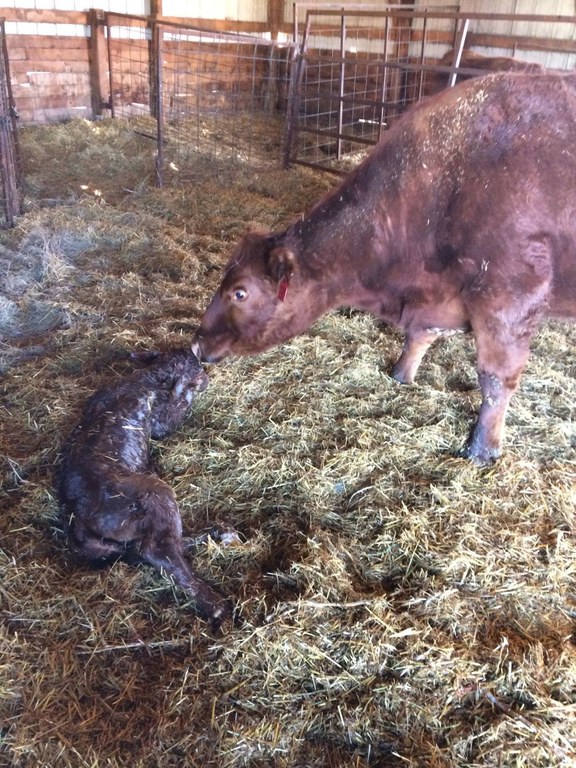
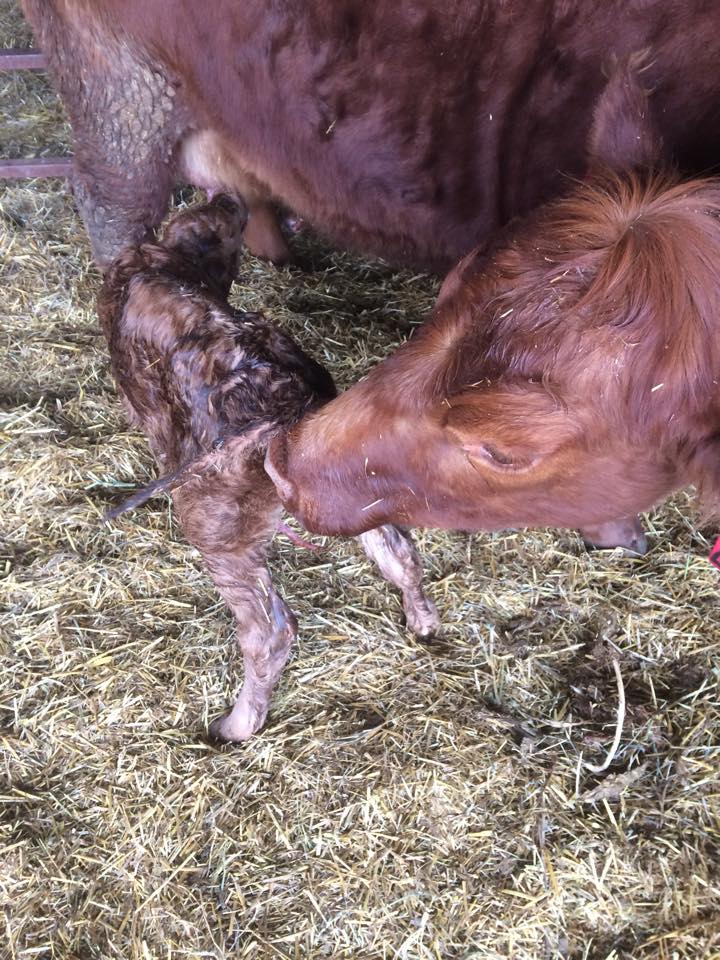
New calves at the CREC!
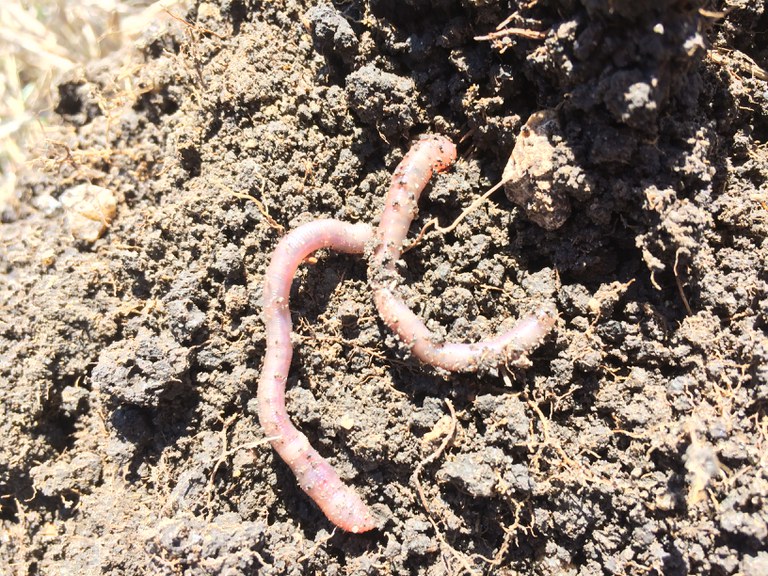
The soil is ready for spring too!
Hazelnut blossom (small red spiny bud, female) and catkins (long plume in foreground, male).

We are also excited to welcome Petra Yuja who was born on February 5, 2017 weighing in at 6 lbs. 15 oz! Petra is the daughter of Szilvia Yuja, CREC research specialist.
As you head into spring's work please keep safety at the forefront of your mind.
Mary Berg
Mary.Berg@ndsu.edu
Area Extension Specialist
PRE Herbicide Program
Spring time is here for most areas of ND. Time to starting thinking of how to carry out the vast plans that were made throughout winter. When it comes to the soybean crop, getting the PRE applied may be one of those logistical challenges we struggle with. However with soybeans your PRE program is the most important component to managing glyphosate resistant weeds. The problem is predicting when an activating rainfall will occur is as difficult as ever even though we know that the amount of rain can impact the success of PRE herbicides. The question then becomes, “how will the herbicide be affected if we don’t get enough rain to activate the product?” We conducted a study in 2016 to answer that question. For those that are interested, here are the materials and methods, otherwise you can skip to the results below:
Three herbicides are of particular interest, Spartan (sulfentrazone), Fierce (flumioxazin + pyroxasulfone), and metribuzin (Sencor), which represent the chemistries of a large portion of the rain activated PRE herbicides for soybeans. Each herbicide was compared in corn stubble that was either tilled or left un-tilled. A center pivot irrigation system was used to simulate rainfall (0.5” of water) for the herbicide activation treatments. The herbicides were activated within 1 day of application, 7 days after application, rotary hoed 7 days after application, or received no activation treatment. The first natural activating rainfall occurred 16 days after treatment so the non-activated treatment was actually activated a little over 2 weeks following herbicide applications. The weeds in the study area were common lambsquarters and redroot pigweed. All existing weeds received glyphosate treatment immediately after planting so that only the pre-emerge component of the herbicides was evaluated.
See Table 1 for a complete list of results. There were a couple key findings from this study. 1) metribuzin did not perform well when activation was delayed by more than a week, and even after 1 week without activation, control of lambsquarters and especially redroot pigweed was less. 2) Rotary hoeing 1 week after applicatoin did not improve the performance of metribuzin. In fact, rotary hoeing reduced the effectiveness of metribuzin in our conventional till treatments (the assumption is that we actually planted weed seeds but did not activate the product. Rotary hoeing however did improve the activity of Spartan under conventional till. 3) Spartan and Fierce were still effective without activation for 7 days, but after that point, Spartan was started to lose effectiveness somewhere between 7 and 16 days after application. The activity of Fierce did not decline in this study, even after 16 days without activation.
Table 1. Comparison of herbicide activation strategies 1 and 7 days after herbicide treatment (DAT) with different herbicide and tillage strategies.
Mike Ostlie, Ph. D.
Mike.Ostlie@ndsu.edu
Research Agronomist
Pruning Your Fruit Trees
It has been a couple of years since I mentioned pruning apple trees, so here are the basics again.
Pruning opens up a tree so that more light and air gets around all of the fruit and leaves. You can also manage the height and shape of the tree. It is best to prune your tree while it is dormant – before buds swell.
Here are the benefits of pruning:
- Reduce the chance of fungal problems by allowing more air to move in the leaves.
- It will be easier to apply product if you need to spray your tree.
- It will reduce the tree’s crop load, making the tree more likely to bear fruit every year.
- The fruit will be larger and ripen faster.
- The tree has more time to prepare for the coming winter when fruit is picked earlier.
Use a sharp, quality hand pruner, lopper or pruning saw (think Felco brand – high quality, more expensive, but you will use them your whole life). Remove branches that point downward, inward, straight up (water sprouts), cross over/through the tree, or will shade the branch below. Clean out small twigs near the center of the tree. Keep branches that are growing outward and upward and look healthy. Start in one place, removing the obvious stuff, and go from there. Don’t be afraid – you can always fix mistakes next year!
Be careful to make cuts at branch collars (see pictures). Do not leave ‘stubs’ which will rot.
Arrow shows branch collar of an inward-pointing branch that needs to be removed.
Arrow shows branch collar after branch removal.
Arrow shows correct position of unfinished saw cut and branch collar.
To prevent disease transmission, use a 1:5 dilution of either bleach, Lysol or Pinesol (1 part disinfectant+ 4 parts water) to spray onto or dip your tools into between trees or between infected branch cuts. Keep in mind, bleach will rust your tools.
Links to more information:
http://www.ag.ndsu.edu/pubs/plantsci/hortcrop/h327.pdf
http://learningstore.uwex.edu/assets/pdfs/A1959.pdf
http://www.mlive.com/weather/index.ssf/2013/03/there_is_still_time_to_prune_f.html
Kathy Wiederholt, Fruit Project Manager
Soybean Seed Inoculation Strategies with Prior Production History
Soybean seed needs to be inoculated with Bradyrhizobium japonicum bacteria to allow plants to produce most of the nitrogen required for seed production on fields with no prior soybean production. Also, if greater than three years are between soybean crops, seed inoculation is recommended.
After at least one year of soybean production in a field that included plants having effective nodulation, will continued seed inoculation increase yield? Averaged over 11 NDSU trials on ground with previously grown soybean, yield increased by 0.5% with inoculated seed compared to non-inoculated seed.
A common strategy is to ‘double’ inoculate soybean seed on new ground – use of two inoculate formulations, typically liquid and granular, at one half to full labeled rates of each. If a farmer chooses to use inoculant for a field with prior soybean history, should the seed be double inoculated? The results of three site-years of research conducted at Carrington and Wishek during 2015-16 are shown in the following figure. Averaged across trials, the data indicates no advantage with single or double inoculation compared to the untreated check.
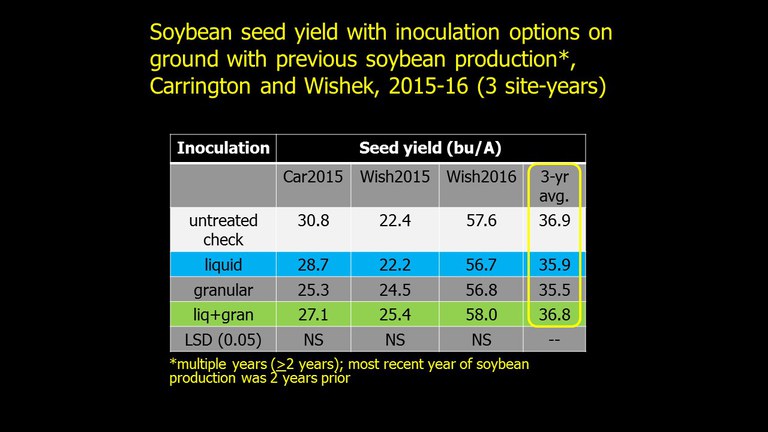
In eastern Manitoba, 25 replicated on-farm trials were conducted during 2013-15 comparing double vs. single seed inoculation in soybean fields that had at least two previous soybean crops. Overall, a significant and economic yield response to double inoculation occurred in 2 out of 25 trials or 8% of the time. The Manitoba Pulse and Soybean Growers Association has the following checklist to help farmers to determine if single inoculation is an economic strategy for fields having prior soybean production. Note all four factors must be met to single inoculate soybean seed.
- Field has had at least two previous soybean crops
- Previous soybean crops had plants with well-nodulated root systems
- Most recent soybean crop within the past four years
- No significant field flooding or drought
Greg Endres
Gregory.Endres@ndsu.edu
Area Extension Agronomy Specialist


